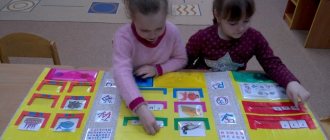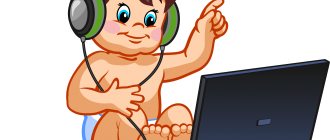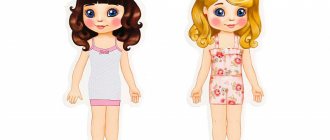Copybooks for preschoolers - letters and numbers
All kinds of copybooks with capital letters and numbers from 1 to 10 are available for preschoolers. The methodological material allows you to develop your hand, fine motor skills, and train concentration and perseverance while performing tasks. To develop logical thinking in preschoolers, it is recommended to use material where numbers are found.
Russian alphabet with tasks
Open
Copybooks with numbers
Open
Recipes for children 5-6 years old
Develop beautiful handwriting in preschool children aged 5 to 6 years. It is advisable to prepare your child for school in advance, since it is at this age that they are easily trained and are able to easily learn something new. If you don't take care of this in advance, children will have a hard time in elementary school.
Capital letters from A to Z
Open
Mathematics copybooks
Open
Recipes for children 6-7 years old
For preschoolers from 6 to 7 years old, it is advisable to use math copybooks, as they will not only be able to develop their hands, but will also easily remember numbers.
Writing aids are also important. With their help, it will be easy to prepare your child for school or help him in first grade. Writing copybooks will not only teach you how to write the elements of letters correctly and at the right angle, but will also help the child learn to read already written capital letters, which often causes a problem at the initial stage of a young student’s education.
Copybooks by points
This type of educational materials has become especially popular today. The dotted recipes are designed for children 5-6 years old.
A child’s thinking at this age is not always capable of assimilating information that he needs to learn to write and count according to certain rules established by the education system. Such standard methods may not be perceived by the baby, so it is better to give preference to learning in the form of a game.
We trace the letters by dots
Open
We trace the figures by points
Open
Circle the numbers by dots
Open
LiveInternetLiveInternet
Development of Children from 5 years to 7 years. You are in the “Children from 5 to 7 years old” section.
In this section, we will help you find out and determine the level of development of your child, namely, what your child should know and be able to do between the ages of 5 and 7 years.
What should a 5 year old child know and be able to do? This article is intended for your information and gives approximate norms for the degree of formation of your child’s mental processes at this age. You can check his potential in different areas of knowledge, find out in which areas of knowledge your child succeeds, and in which additional attention and time are required. In this section “Children from 5 to 7 years old” we have collected all the material published on our website that will help you and your child study and prepare for the next, more in-depth stage of classes. You can use the materials for your classes at home, in kindergarten or in primary school. Mathematics
A child aged 5 to 7 years should be able to:
1. The child must be able to solve simple problems and puzzles. 2. The child must be able to subtract and add to numbers. 3. The child must be able to determine the direction: forward, backward, right, left, up, down. 4. The child must be able to count objects within 10 based on operations with sets. 5. The child must be able to compare numbers: equalities - inequalities, more - less. 6. The child must understand and correctly answer the questions: How much? Which? Which one? 7. The child must know the composition of the first ten numbers. 8. The child must be able to distinguish and name objects of round, square, triangular and rectangular shapes. 9. The child must know such geometric shapes as: square, rectangle, circle, triangle, trapezoid, rhombus; geometric bodies: cube, ball, cylinder, pyramid. 10. The child must know the signs “+”, “-“, “=”, “<;” and ">;". 11. The child must be able to compose and solve one-step addition and subtraction problems. 12. The child must be able to divide a circle or square into two and four equal parts. 13. The child must know the direct and reverse order of the number series.
Aids for classes:
1. Connect the numbers and color the picture 2. Cards Numbers 3. Connect the dots and see what happens 4. Cards “which number is extra” 5. Copy. Learning to write Numbers 6. Subtraction and Addition 7. Copy.
Numbers 8. Cards with Numbers 9. Numbers in words 10. Cards with Numbers-coloring 11. Mathematical tasks for memory development 12. Geometric figures. Developing memory 13. Geometric shapes. Developing fine motor skills 14. Mathematical tasks for a preschooler 15. Copybook for Mathematics 16. Learning to Count. Workbook 17. Learning to write Numbers from 1-9 18. Mathematical examples for a preschooler 19. Games with Geometric shapes 20. Developing memory with Geometric shapes 21 My first copybook in Mathematics 22. Entertaining tasks in mathematics 23. Learning to count from 1 to 100 24. Workbook in Mathematics (from 6 years old) 25. Match Quantity with Number 26. Orientation in space. Before and After 27. Counting within 10. Consolidation 28. Copybooks - Types of Transport 29. Strengthening the count within 20 30. Cards with Numbers 31. Puzzle Counting from 1 to 10 32. Mathematics with Dice 33. Puzzle Counting from 1 to 10 10 34. Math with Dice for Children 35. Puzzle Counting from 1 to 10 36. Coloring book for children about Horses 37. Cards Numbers and Signs Logical thinking - Development of Thinking, Memory, Attention
A child aged 5 to 7 years should be able to:
1. The child must be able to complete tasks in which it is necessary to identify a pattern and continue a series of proposed items. 2. The child must find an extra item from 4-5 items offered. 3. The child must be able to compose a story based on the proposed pictures, and be able to finish the story (come up with an ending). 4. The child must be able to divide the proposed objects into two groups and find a common feature for each group.
Aids for classes:
1. Cards from the series find the extra object 2. Cards from the series find the extra object.
Part 2 3. Read the encrypted message 4. Whose shadow is here 5. Big-small cards 6. Krasnoukhov's puzzle 7. Logical coloring pages 8. Development of Attention 9. Development of Thinking 10. Development of Memory 11. Development of Memory. Part 2 12. School for preschool children . Developing thinking 13. Pentamino game 14. Game of opposites (Antonyms) 15. Find a pattern and continue the series 16. Orientation in space. Right and Left 17. Game - “What is What?” 18. Logic problems for Preschoolers 19. Rebuses and Puzzles for Children 20. Association game: Find a pair 21. Entertaining Logic. Think in a Square 22. Magic cells and dots 23. Game for the Development of Memory and Attention 24. Game “What for what? » 25. Puzzles for Children. Part 1 26. Puzzles for Children. Part 2 27. Game for Concentration of Attention 28. Collect the Word from the Picture and Letters. Didactic Game Speech Development
A child aged 5 to 7 years should be able to:
1. The child must state his first and last name, how old he is, name the city in which he lives, the names of his parents, how old they are, where and who they work for. 2. The child must know the home address, home telephone number 3. The child’s speech should be as close as possible to adult speech (in quality). 4. The child must know what intonation is and must use it to express his emotions. 5. The child must be able to distinguish an incentive sentence from a narrative one, an exclamatory sentence from an interrogative one, and must be able to use them. 6. The child must be able to formulate and ask questions, reason, and argue. 7. The child must be able to conduct dialogue and monologue. 8. The child should know a lot of poems memorized, complex and large works. He must tell the story with expression.
Aids for classes:
1. Video ABC for children.
Learning to read 2. ABC in the form of cards 3. How to teach a child to read syllable by syllable 4. Learning to Read. Part 1 5. Learning to Read. Part 2 6. Learning to Read. Part 3 7. Colored letters of the Alphabet 8. Unique Alphabet by letter 9. How to prepare your hand for writing 10. How to prepare your hand for writing. Part 2 11. Copybook learning to read and write 12. Reading nursery rhymes 13. Cards with Syllables 14. Workbook for a preschooler 15. Pure sayings 16. Hard and Soft consonant sounds (Cards) 17. Counting books and Counting books 18. Vowel plus Consonant Syllables 19. Reading and Speech Development 20. Introducing the Child to Prepositions 21. Coloring - Solve, Remember, Draw 22. Reading Word Combinations 23. Collect the Word from the Picture and Letters 24. Cards - Which Letter does the Word Start with 25. Collect the Word from the Picture and Letters. Didactic Game The world around us
A child aged 5 to 7 years should be able to:
1. The child must know the names of all the objects around him: furniture, dishes, clothes, household and electrical appliances, plants, animals, natural phenomena, the names of his favorite cartoons, fairy tales, books, the names of his favorite characters.
Aids for classes:
1. Cards with images of Transport 2. Cards Parts of the human body 3. Cards with Fruits 4. Cards with Vegetables 5. Cards learning Colors 6. Cards Furniture 7. Cards “animals and what they eat” 8. Cards Animals and Birds 9. Cards Professions 10. Structure of Tree and Leaves 11. Season Autumn 12. Season Winter 13. Season Spring 14. Season Summer 15. Cards learning Colors 16. Winter month - December
17. Winter month - January
18. Winter month - February 19. Classes on the theme Winter 20. Fruits and berries. Study and color 21. Vegetables. Study and color 22. Fruits and Berries (coloring cards)
23. Spring month - March 24. Spring month - April 25. Spring month - May 26. Unique books - Seasons 27. Summer month - June 28. Summer month - July 29. Summer month - August 30. Autumn months - September 31 Autumn months - October 32. Autumn months - November 33. Cards Electrical household appliances 34. About Professions for children 35. What does a House consist of?
36. Cards Insects 37. About Mushrooms for Children 38. Cards Home Craftsman Tools 39. Crockery and Cutlery 40. The world around us 41. Cards Game “What for What” 42. Cards Insects 2. 43. Cards Professions. Part 2 44. Cards Flowers 45. Cards Seasons and Natural Phenomena 46. Educational Games with Clothespins Household Skills
A child aged 5 to 7 years should be able to:
1. The child must be able to make phone calls. 2. The child must know how to thread a needle, how to sew on a button 3. The child must know how to behave at the table. 4. The child must brush his teeth and rinse his mouth after eating. 5. The child must be able to fasten buttons and tie shoelaces. 6. The child must know what it means to be neat, must be able to take care of his hair, nails and the condition of his clothes. 7. The child must know what a traffic light is for, what each color of the traffic light is for, how and where to cross the road. 8. The child must know the name of the current month and the sequence of days of the week.
Teaching aids:
1. How to teach a child to tie shoelaces 2. Trace and color 3. Paper fruits 4. Tic-tac-toe game in a new way 5. Signs and Properties of objects 6. Flowers applique 7. Getting to know the concepts: Right, left , above, below 8. Studying the Clock 9. Parts of the Human Body 10. Copybook for Left Handers 11. Game - all Professions 12. My Home.
Components of a house. 13. Lotto for children - Studying Time 14. Plasticine and beads 15. Board Game Tell us about your city 16. City tour with exciting tasks 17. Children's Counting Books 18. Applications from Buttons 19. DIY Christmas tree from Pine cones 20. Merry Chupa- Chups 21. Children's Wall Clock 22. Children's Bookmarks for English Language
A child between the ages of 5 and 7 can be introduced to the English language. Use textbooks for parents and teachers for teaching English to children aged 5 to 7 years.
Aids for classes:
1. English Puzzle Letters 2. English with Disney characters 3. English with Disney characters.
Part 2 4. Cards with Letters of the English alphabet 5. Non-colored cards with Letters 6. Cards with animals and birds in English 7. Number cards in English 8. Choose the correct word 9. Cards Fruits and Berries 10. Cards with English words. Part 1 11. Cards with English words. Part 2 12. Cards Furniture in English 13. Cards Household Electrical Appliances 14. English with Disney characters. Part 3 15. Learning to write English letters 16. English with Disney characters. Part 4 17. Cards Clothes 18. Cards Vegetables in English 19. Cards Transport in English 20. Puzzles Large and small letters of the English alphabet 21. Cards Months in English Testing the Knowledge of a Preschooler
Dear Parents!
We offer you a list of questions that will help determine how ready your child is to enter school. To the questions presented, you will find possible answers that your child can use.
We all know that testing children before entering school is not provided for by current legislation. But this is on paper. In practice, testing will be a mandatory step when entering a gymnasium or simply a prestigious school. Moreover, the same testing, only under the name “interview”, will most likely be offered to the child before entering any educational institution...
When selecting questions, we used topics that are widely used when interviewing children entering school. Mathematics, Logic, Attention, Memory, Natural history, Social education, Speech development.
1. Testing the Knowledge of a Preschooler 2. Testing the Knowledge of a Preschooler 3. Testing the Knowledge of a Preschooler 4. Testing the Knowledge of a Preschooler
Copybooks for schoolchildren
Such copybooks are often requested at school in order to give the very basics that are so necessary for a child at the initial level of education. Many parents decide to purchase additional worksheets to help them improve their child’s skills at home. In any case, such copybooks provide all the necessary basic knowledge, which will become the foundation for teaching a child to read and write.
Recipes for 1st grade
Copybooks for first-graders can easily be called the main notebooks in elementary school. The child’s task is to learn to write beautifully and quickly. For a child, such a task seems insurmountably difficult. In the first grade educational program, very little time is devoted to copywriting.
The copybooks contain many pictures that make learning easier and help to divert the child’s attention, when necessary, from the difficult task of learning the elements of lowercase letters.
Capital letters and words
Open





